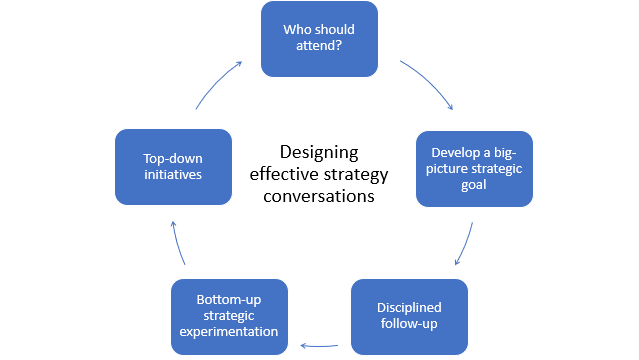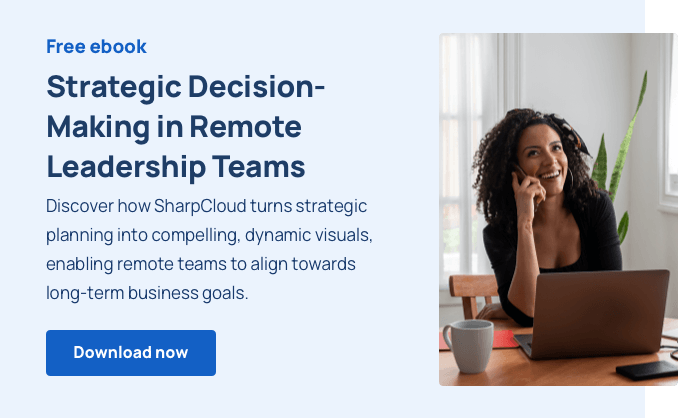Despite all the time and energy most companies put into strategic planning, the traditional annual process is most often a barrier to good decision making...
- “It takes too much time"
- "It’s at too high a level"
- "It’s disconnected from the way we run the business.”
Forward-looking companies are throwing out their calendar-driven, business-unit-focused planning processes and replacing them with continuous, issues-focused, data driven decision making, using technology to enhance internal communication and collaboration.
By changing the timing and focus of strategic planning, you change the nature of top management’s discussions about strategy—from 'review and approve' to 'debate and decide,' meaning that senior executives seriously think through every major decision and its implications for the company’s performance and value. In place of the previous rigidity and divergence, strategy, road mapping and co-innovation all become organic, continually adapting as the future unfolds.
What is the purpose of strategic planning?
It can add value if it achieves two goals. The first is to ensure that decision makers have a solid understanding of the business, its strategy, and the assumptions behind that strategy, thereby making it possible for executives to respond swiftly to challenges and opportunities as they occur in real time.
The second goal is to increase the innovativeness of companies strategies. No strategy process can guarantee brilliant flashes of creative insight, but much can be done to increase the odds that they will occur.
Traditional vs real time strategic planning
If you compared the list of Fortune 500 companies today with the list of a few decades ago, you might be surprised to see how many older firms have disappeared. With the accelerating pace of business, new, nimbler companies have been ousting established ones.
Not only do they bring new business models, but they also adapt faster to changes in their markets. Instead of an annual strategizing exercise, they can evolve their strategy within a few months, weeks, or even days. This agility is part of their DNA. Many start-ups also use technology to enhance internal communication and collaboration, boosting responsiveness to changes in customer needs and wants.
Other enterprises need to create similar levels of agility and responsiveness in their strategies and actions, if they are to keep up in the business world. Organizational fiefdoms and silos are luxuries that many enterprises can no longer afford. They need tools to get everybody contributing to, aware of, and aligned with strategy formulation and execution, however fast it changes.
Agile strategic planning model

Who should attend? Real conversations take place in small gatherings of no more than ten. Attendees at strategy reviews should be limited to the principal strategic decision makers. More executives will fight to be involved, but they can be kept "in the loop" through other forums.
In-depth discussions of strategy take time. Strategy execution isn’t the last step in strategic planning. Develop a big-picture communications strategic goal. Your strategy may be emergent, gradually being defined as teams find responses to different business challenges.
Disciplined follow-up is essential. Participants need to be kept informed and connected. Stakeholders at all levels need to see and comment on the strategy and how it is unfolding over time. The relationships between these things can be complex and change dynamically. In the case of an emergent strategy, the execution may feed information back that then changes the strategy.
Bottom-up strategic experimentation occurs when a company pursues a variety of strategic options in parallel within a given business. When a strategy is not immediately obvious, constructive discussion and “what if” scenarios to evaluate different strategies can help to pick the best.
Top-down initiatives can breed creativity. All companies occasionally face issues that are bigger than their individual business units and require the broad engagement of the whole organisation. These situations offer the opportunity for a CEO and senior management to add strategic value to a company.
Strategic decision making tools
Done right, strategic planning can have an enormous impact on a company’s performance and long-term value. By creating a planning process that enables managers to uncover hidden strategic issues and make better decisions, companies will become more agile.
By embracing decision-focused planning, companies will almost certainly find that the quantity and quality of their decisions will improve, as will the quality of the dialogue between senior corporate managers and unit managers. Corporate executives will gain a better understanding of the challenges their companies face, and unit managers will benefit fully from the experience and insights of the company’s leaders.
.jpg?width=300&name=Website_Fortune500%20(optimized).jpg)


